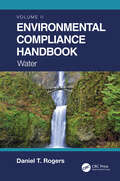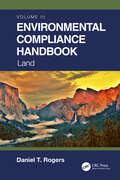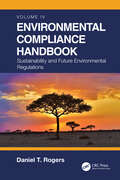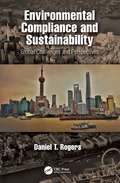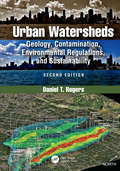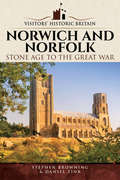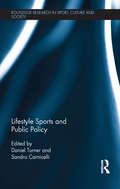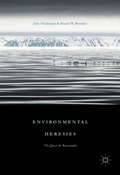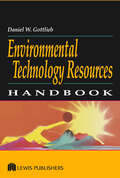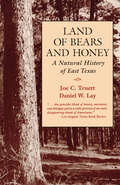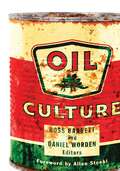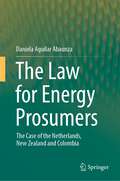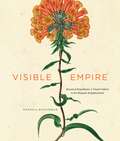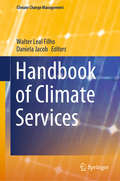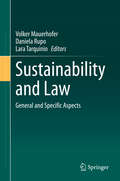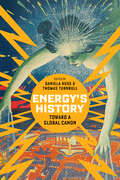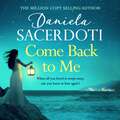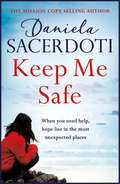- Table View
- List View
Environmental Compliance Handbook, Volume 2: Water
by Daniel T. RogersEnvironmental laws and regulations are extremely complex and difficult to understand. In order to comply with them, they need to be explained in layperson’s terms. This handbook identifies many changes in regulations and recommends ways to apply and implement them. Containing the latest environmental information, this volume addresses environmental compliance with water and provides a historical perspective to help follow the logical growth and increased complexity of water regulations through time. Structured as a “step-by-step how-to” book, readers will find real-life examples for the most important aspects of language, permit terms, demonstrating compliance, and organization for water projects. Features: Identifies all water pollution control regulations and the requirements of any water pollution control permits available up to date Answers in depth all practical questions that arise when working on compliance projects in a "how-to" method Addresses a wider spectrum of issues that go beyond chemical-based contamination and environmental regulations and examines the impacts of climate change Includes many real-life examples and case studies from industry and institutions that comply with water quality regulations It is global in coverage and very useful to companies that have expanded operations outside their country of origin
Environmental Compliance Handbook, Volume 3: Land
by Daniel T. RogersEnvironmental laws and regulations are extremely complex and difficult to understand. In order to comply with them, they need to be explained in layperson’s terms. The handbook identifies many changes in regulations and recommends ways to apply and implement them. Containing the latest environmental information, this third volume addresses environmental compliance with land and provides a historical perspective to help follow the logical growth and increased complexity of land regulations through time. Structured as a “step-by-step how-to” book, readers will find real-life examples for the most important aspects of language, permit terms, demonstrating compliance, and organization for land projects. Features: Introduces all land pollution control regulations and the requirements of any land pollution control permits available up to date Answers in depth all practical questions that arise when working on compliance projects in a "how-to" method Addresses a wider spectrum of issues that go beyond chemical-based contamination and environmental regulations and examines the impacts of climate change Includes many real-life examples and case studies from industry and institutions that comply with land use regulations It is global in coverage and very useful to companies that have expanded operations outside their country of origin
Environmental Compliance Handbook, Volume 4: Sustainability and Future Environmental Regulations
by Daniel T. RogersEnvironmental laws and regulations are extremely complex and difficult to understand. In order to comply with them, they need to be explained in layperson’s terms. This handbook identifies many changes in regulations and recommends ways to apply and implement them. Containing the latest environmental information, this volume goes beyond environmental regulations in two fundamental aspects: sustainability and preparation for future requirements before mandates are enacted. Structured as a “step-by-step how-to” book, readers will find real-life examples for the most important aspects of evaluating sustainability initiatives and preparing for new and revised environmental regulations. Features: Explores all sustainability related concepts and regulations and the requirement of any control permits available up to date. Answers in depth all practical questions that arise when working on compliance projects for future requirements. Addresses a wider spectrum of sustainability issues that go beyond chemical-based contamination and environmental regulations and examines the impacts of climate change. Includes many real-life examples and case studies from industry and institutions that comply with sustainability regulations. It is global in coverage and very useful to companies that plan to expand operations outside their country and are interested in future regulations.
Environmental Compliance and Sustainability: Global Challenges and Perspectives
by Daniel T. RogersThis book provides a critical understanding of the challenges that exist in protecting the local and global environment through compliance efforts using existing environmental regulations. The best compliance measures with the most useful regulations from over 50 countries are surveyed and are combined with science-based quantitative analysis of geology, hydrogeology, and the chemistry of contaminants from anthropogenic sources. The results are presented as a model that establishes a means by which protection of the environment can be greatly improved. This is accomplished through a deeper understanding of our natural world and how anthropogenic activities and their management affect our planet. Features The first book that examines the successes of environmental regulation worldwide and highlights the areas that need improvement Presents a tested and verified scientific model for enhanced environmental protection with scalability from local parcels to global levels Describes and integrates the importance of understanding the geologic and hydrogeologic environment of urban and developed areas Explains the importance of understanding the different types of pollution and their behavior in the environment Identifies the need for consistency in banning chemicals that are harmful in not just one country but throughout the world
Urban Watersheds: Geology, Contamination, Environmental Regulations, and Sustainability, Second Edition
by Daniel T. RogersUnderstanding that the natural world beneath our feet is the point at which civilization meets the natural world is critical to the success of restoration and prevention efforts to reduce contaminant impacts and improve the global environment because of one simple fact – contaminants do not respect country borders. Contaminants often begin their destructive journey immediately after being released and can affect the entire planet if the release is in just the right amount, at just the right location, and at just the right time. Taking an interdisciplinary approach, Urban Watersheds, Geology, Contamination, Environmental Regulations, and Sustainability, Second Edition presents more than 30 years of research and professional practice on urban watersheds from the fields of environmental geology, geochemistry, risk analysis, hydrology, and urban planning. The geological characteristics of urbanized watersheds along with the physical and chemical properties of their common contaminants are integrated to assess risk factors for soil, groundwater, and air. This new edition continues to examine the urban environment and the geology beneath urban areas, evaluates the contamination that affects watersheds in urban regions, and addresses redevelopment strategies. Features of the Second Edition: Examines contaminants and the successes of environmental regulation worldwide and highlights the areas that need improvement Describes several advances in investigation techniques in urban regions that now provide a huge leap forward in data collection, resolution, and accuracy Explains the importance of understanding the geological and hydrogeologic environments of urban and developed regions Provides new and enhanced methods presented as a sustainability model for assessing risks to human health and the environment from negative human-induced contaminant impacts Includes a new chapter that surveys how environmental regulations have been successful or have failed at protecting the air, water, and land in urban areas Suitable for use as a textbook and as a professional practice reference, the book includes case studies on successful and unsuccessful approaches to contaminant remediation as well as practical methods for environmental risk assessment. PowerPoint® presentations of selected portions of the book are available with qualifying course adoption. Daniel T. Rogers is currently the Director of Environmental Affairs at Amsted Industries Inc. in Chicago, Illinois. His writings address environmental geology, hydrogeology, geologic vulnerability and mapping, contaminant fate and transport, urban geology, environmental site investigations, contaminant risk, brownfield redevelopment, and sustainability. He has taught geology and environmental chemistry at Eastern Michigan University and the University of Michigan.
Norwich and Norfolk: Stone Age to the Great War (Visitors' Historic Britain)
by Stephen Browning Daniel TinkA traveler’s guide to the history of Norwich and Norfolk, from the Stone Age to the dawn of World War I, featuring guided tours, photos, and more.Whether you’re traveling alone, with friends, or with your family, this guide has something for everyone wishing to explore the host of fascinating places on offer in what the Norfolk-born authors believe to be the most unspoiled and mysterious county in England. Norwich has its own section along with three possible walks taking in many of the recommended sites. The vast coast is presented next and finally the book travels to central Norfolk: places of interest are grouped as much as possible so that travelers can make the most of the time available. Everywhere, legends and stories relating to an area are woven into the narrative. A final chapter considers Norwich and Norfolk through time using rare archive and archaeological material to give a taste of life in days gone by. Top Norfolk photographer Daniel Tink has taken 100 photographs especially for the book and presents these where appropriate alongside some wonderful contrasting old prints and etchings. The book concludes with a comprehensive index and bibliography designed to facilitate further study. Throughout, telephone numbers and websites of attractions are given, providing readers with a “toolkit” to unlock the secrets, history, sites, and stories of this vast county.“A magical journey through the streets of Norwich and around the countryside and coastline of Norfolk. There’s even a tale about a ghost in the ruined priory . . . . Superb stories . . .full of information and very readable indeed.” —Books Monthly (UK)
True Blue: The Oxford Boat Race Mutiny
by Patrick Robinson Daniel TopolskiFrom the book: In the harsh winter of 1986/7, an event took place in the Oxford University Boat Club which shook the University, and the rowing establishment, to their foundations. It became known, simply, as the Oxford Mutiny. A group of American students, all former internationals, had arrived at Oxford hoping to put some steel into a Boat Race crew still reeling from their recent humiliating defeat at the hands of Cambridge - a hammering which had ended an astounding ten-year winning streak by Oxford. But disagreements over training methods soon brought into focus a bitter clash of personalities between a quiet Scottish mature student, Donald Macdonald, the elected president of the Dark Blues, and a fierytempered rower from California, Christopher Clark. Embodying the amateur sporting traditions of the Boat Race on the one hand, and New World big-star sportsmanship on the other, these two men found two warring factions lining up behind them. The ensuing battle for the control of the Oxford University Boat Club raged for months, making headline news all over the world. Daniel Topolski who, as Chief Coach, had been the architect of Oxford's success, and who now found himself in the middle of this unprecedented row, has finally told his side of the story. Having lost their bid to oust Macdonald, the rebels pulled out of the Boat Race squad just six weeks before the race. Could he, against all odds, mould the inexperienced and demoralised reserve crew of no-hopers into a winning team? Reminiscent of Chariots of Fire, this book is not just about rowing, or even about sport. It concerns the clash of traditional and modern values; petty hatreds and great friendships; and, above all, the triumph of the human spirit.
Lifestyle Sports and Public Policy (Routledge Research in Sport, Culture and Society)
by Daniel Turner Sandro CarnicelliLifestyle Sports and Public Policy is the first book to develop a comprehensive understanding of the interplay between lifestyle sports and the public policy environment which frames and regulates them. Drawing on a wide range of lifestyle sports from across the globe, including parkour, skateboarding, mountain biking and climbing, it identifies the critical issues facing practitioners and policymakers as these sports become increasingly popular. Part I examines public sector bodies that provide lifestyle sports opportunities to the public, either through funding partners or by managing facilities themselves. Part II looks at the use of lifestyle sports to promote policy agendas such as improving public health, while Part III considers the impact of public sector regulatory actions on the lifestyle sports industry. Each part contains case studies which investigate a policy issue from the perspective of a different lifestyle sport, including some sports which have traditionally been under-represented such as rodeo and curling. This book is a valuable resource for anyone with an interest in lifestyle sports, leisure studies, sport tourism, leisure management or sport policy.
Environmental Heresies
by Juha Hiedanpää Daniel W. BromleyThis book systematically deconstructs the pervasive and counter-productive discourse surrounding environmental policy. The authors argue that environmental policy problems are always framed such that conflict is inevitable--a particular project or policy must be accepted versus a specific environmental asset that must be protected. Over the course of 12 chapters, the authors demonstrate that confident yet contradictory assertions by contending interests preclude necessary deliberation and reason giving. They argue that deliberation is an important social process of reflecting upon the reasons for doing something. Their innovative approach allows discourse and collaboration to continue, until--after honest and informed deliberation--the better way forward is arrived at. This approach to environmental policy illustrates just how very constructive and enabling the quest for the reasonable can be.
Environmental Technology Resources Handbook
by Daniel W. GottliebThis handbook guides the user to hundreds of technologies, practices, partnership opportunities, and funding resources. Presented in non-technical language, it covers hundreds of publicly available resources for pollution prevention, control, remediation, and assessment. Environmental Technology Resources Handbook will help you:
Land of Bears and Honey: A Natural History of East Texas
by Joe C. Truett Daniel W. LayThis award-winning &“gem&” of a conservation classic tells the story of the land, wildlife, and ecology of East Texas (Quarterly Review of Biology).Winner of the Ottis Lock Endowment Award from the East Texas Historical Association; the Texas Literary Festival Award for Nonfiction from the Southwestern Booksellers Association & Dallas Times Herald; and the Annual Publication Award, Texas Chapter of the Wildlife Society As hickory groves and fox squirrels began to vanish from the East Texas landscape in the second half of the twentieth century, two biologists who specialized in wildlife and endangered species began work on Land of Bears and Honey. Their purpose was not only to eulogize what was lost, but to encourage us to save what we still can. The result is an &“elegant chronicle of the natural history of a once-rich area [that] will appeal strongly to birders, ecologists, to anyone who enjoys the outdoors&” (Publishers Weekly). &“This deceptively slender volume is three things: a how-to-book, an aesthetic feast and a moral tale.&” —Dallas Morning News &“To compare the style and content of this little book to that of the late Aldo Leopold is indeed high praise, yet the reviewer finds this comparison valid.&” —Quarterly Review of Biology &“In Land of Bears and Honey, East Texans have their own regional Walden, written with keen historical perspectives, literary style, and deep respect for the land.&” —East Texas Historical Journal &“This graceful blend of history, narrative and dialogue paints a noble portrait of one more disappearing chunk of Americana.&” —Los Angeles Times Book Review
Land of Bears and Honey: A Natural History of East Texas
by Joe C. Truett Daniel W. LayThis award-winning &“gem&” of a conservation classic tells the story of the land, wildlife, and ecology of East Texas (Quarterly Review of Biology).Winner of the Ottis Lock Endowment Award from the East Texas Historical Association; the Texas Literary Festival Award for Nonfiction from the Southwestern Booksellers Association & Dallas Times Herald; and the Annual Publication Award, Texas Chapter of the Wildlife Society As hickory groves and fox squirrels began to vanish from the East Texas landscape in the second half of the twentieth century, two biologists who specialized in wildlife and endangered species began work on Land of Bears and Honey. Their purpose was not only to eulogize what was lost, but to encourage us to save what we still can. The result is an &“elegant chronicle of the natural history of a once-rich area [that] will appeal strongly to birders, ecologists, to anyone who enjoys the outdoors&” (Publishers Weekly). &“This deceptively slender volume is three things: a how-to-book, an aesthetic feast and a moral tale.&” —Dallas Morning News &“To compare the style and content of this little book to that of the late Aldo Leopold is indeed high praise, yet the reviewer finds this comparison valid.&” —Quarterly Review of Biology &“In Land of Bears and Honey, East Texans have their own regional Walden, written with keen historical perspectives, literary style, and deep respect for the land.&” —East Texas Historical Journal &“This graceful blend of history, narrative and dialogue paints a noble portrait of one more disappearing chunk of Americana.&” —Los Angeles Times Book Review
Oil Culture
by Daniel Worden Ross BarrettIn the 150 years since the birth of the petroleum industry oil has saturated our culture, fueling our cars and wars, our economy and policies. But just as thoroughly, culture saturates oil. So what exactly is &“oil culture&”? This book pursues an answer through petrocapitalism&’s history in literature, film, fine art, wartime propaganda, and museum displays. Investigating cultural discourses that have taken shape around oil, these essays compose the first sustained attempt to understand how petroleum has suffused the Western imagination.The contributors to this volume examine the oil culture nexus, beginning with the whale oil culture it replaced and analyzing literature and films such as Giant, Sundown, Bernardo Bertolucci&’s La Via del Petrolio, and Ben Okri&’s &“What the Tapster Saw&”; corporate art, museum installations, and contemporary photography; and in apocalyptic visions of environmental disaster and science fiction. By considering oil as both a natural resource and a trope, the authors show how oil&’s dominance is part of culture rather than an economic or physical necessity. Oil Culture sees beyond oil capitalism to alternative modes of energy production and consumption.Contributors: Georgiana Banita, U of Bamberg; Frederick Buell, Queens College; Gerry Canavan, Marquette U; Melanie Doherty, Wesleyan College; Sarah Frohardt-Lane, Ripon College, Matthew T. Huber, Syracuse U; Dolly Jørgensen, Umeå U; Stephanie LeMenager, U of Oregon; Hanna Musiol, Northeastern U; Chad H. Parker, U of Louisiana at Lafayette; Ruth Salvaggio, U of North Carolina, Chapel Hill; Heidi Scott, Florida International U; Imre Szeman, U of Alberta; Michael Watts, U of California, Berkeley; Jennifer Wenzel, Columbia University; Sheena Wilson, U of Alberta; Rochelle Raineri Zuck, U of Minnesota Duluth; Catherine Zuromskis, U of New Mexico.
The Law for Energy Prosumers: The Case of the Netherlands, New Zealand and Colombia
by Daniela Aguilar AbaunzaThis book argues that law has a vital role in shaping the electricity system to enable a more active role for consumers in liberalizsed electricity industries. To do that, this book offers a unique legal perspective of the Netherlands, New Zealand and Colombia to help understand some of the current legal approaches to prosumers and therefore the legal challenges and opportunities facing. Law and regulation have the role of creating a level playing field for emerging participants, such as prosumers, to participate and compete in the market together with traditional actors, bringing not only more competition but also representing a more sustainable, environmental and democratic way to supply energy. Furthermore, law and regulation have the role of responding to innovation and creating space for technological advances to procure the changes in the industry without delay. This book examines some of the legal barriers for the raise of energy prosumers. The traditional role of the distributor when responding to increasing distributed generation in the network; prosumers unable to decide to whom they can sell their electricity to; the price of the energy or even whether to participate more actively in demand response programs. A further issue is the lack of clarity about whether small prosumers are entitled to consumer protection rights and legal challenges regarding configuration, access to the network, access to markets and strict unbundling rules for community energy projects. This book provides a clear, analytical, and informed approach to understanding the regulatory framework around energy prosumers. It will appeal to policy makers, lawyers, individuals, business entrepreneurs or communities wanting to engage in energy projects, as well as academics, researchers and students
Visible Empire: Botanical Expeditions and Visual Culture in the Hispanic Enlightenment
by Daniela BleichmarBetween 1777 and 1816, botanical expeditions crisscrossed the vast Spanish empire in an ambitious project to survey the flora of much of the Americas, the Caribbean, and the Philippines. While these voyages produced written texts and compiled collections of specimens, they dedicated an overwhelming proportion of their resources and energy to the creation of visual materials. European and American naturalists and artists collaborated to manufacture a staggering total of more than 12,000 botanical illustrations. Yet these images have remained largely overlooked—until now. In this lavishly illustrated volume, Daniela Bleichmar gives this archive its due, finding in these botanical images a window into the worlds of Enlightenment science, visual culture, and empire. Through innovative interdisciplinary scholarship that bridges the histories of science, visual culture, and the Hispanic world, Bleichmar uses these images to trace two related histories: the little-known history of scientific expeditions in the Hispanic Enlightenment and the history of visual evidence in both science and administration in the early modern Spanish empire. As Bleichmar shows, in the Spanish empire visual epistemology operated not only in scientific contexts but also as part of an imperial apparatus that had a long-established tradition of deploying visual evidence for administrative purposes.
Natural Disasters and Adaptation to Climate Change
by Sarah Boulter Jean Palutikof David John Karoly Daniela Guitart Sarah Boulter Jean Palutikof David John KarolyThis volume presents eighteen case studies of natural disasters from Australia, Europe, North America and developing countries. By comparing the impacts, it seeks to identify what moves people to adapt, which adaptive activities succeed and which fail, and the underlying reasons, and the factors that determine when adaptation is required and when simply bearing the impact may be the more appropriate response. Much has been written about the theory of adaptation, and high-level, especially international, policy responses to climate change. This book aims to inform actual adaptation practice - what works, what does not, and why. It explores some of the lessons we can learn from past disasters and the adaptation that takes place after the event in preparation for the next. This volume will be especially useful for researchers and decision makers in policy and government concerned with climate change adaptation, emergency management, disaster risk reduction, environmental policy and planning.
Handbook of Climate Services (Climate Change Management)
by Walter Leal Filho Daniela JacobThis book explores climate services, including projections, descriptive information, analyses, assessments, and an overview of current trends. Due to the pressures now being put on the world’s climate, it is vital to gather and share reliable climate observation and projection data, which may be tailored for use by different groups. In other words, it is essential to offer climate services. But despite the growth in the use of these services, there are very few specialist publications on this topic. This book addresses that need. Apart from presenting studies and the results of research projects, the book also offers an overview of the wide range of means available for providing and using climate services. In addition, it features case studies that provide illustrative and inspiring examples of how climate services can be optimally deployed.
Sustainability and Law: General and Specific Aspects
by Volker Mauerhofer Daniela Rupo Lara TarquinioThe book discusses sustainability and law in a multifaceted way. Together, sustainability and law are an emerging challenge for research and science. This volume contributes through an interdisciplinary concept to its further exploration. The contributions explore this exciting domain with innovative ideas and replicable approaches. It combines a variety of authors, from both the public and the private sectors, and thereby guarantees a broad view that enshrines the more theoretical arguments from the academic side as well as stronger practical applicable perspectives. The book provides space for thoughtful expansions of established theories as well as the hopeful emergence of innovative ideas. Moreover, the combination of three to five contributions into the eleven parts respectively aims toward a compression of like minded thoughts. This should lead to an intensification of exchange of viewpoints from different angles on a similar theme. Readers therefore also have the opportunity to concentrate on single chapters, but receive comprised knowledge and a variety of thoughts for new ideas on a particular theme.
Energy's History: Toward a Global Canon
by Daniela Russ and Thomas TurnbullEnergy history is an approach to understanding the past that takes changes in the human exploitation of Earth's energies as its object of inquiry. This interdisciplinary field documents and analyzes how humans have thought about, harnessed, stored, and exploited stocks and flows of energy. In recent decades, in response to evidence of the effect of fossil fuel use in our climatic system and coinciding with an energy turn across the humanities, a new urgency and purpose has been ascribed to such work. Energy's History challenges abstract and universalizing conceptions of energy's history-making capacities. Each of the twelve essays in this collection presents, analyzes, and contextualizes a primary source. The contributors focus on ideas, events, and statements that recorded and critiqued the distinct historical paths of energy, thereby broadening the scope of where and what constitutes energy history. As energy's world-making has enmeshed ever more of the planet into a dangerous compact with fossil fuels, energy histories must be revised within this new energy-historical reality. This volume both presents persuasive visions of energy-driven development beyond the Western capitalist model and provides an expansive and critical account of the ways in which energy histories have shaped the past and impact the present.
Come Back to Me (A Seal Island novel): A gripping love story from the author of THE ITALIAN VILLA
by Daniela SacerdotiFrom the bestselling author of The Italian Villa and Watch Over Me, a romantic, moving and uplifting story of three different lives, connected by a thread. Perfect for anyone who loves Fiona Valpy and Lily Graham.'Atmospheric, romantic and compelling. Daniela writes with huge warmth and sincerity' Rosanna LeyThree separate lives. Three broken hearts.Haunted by his wife's death, Matt arrives on Seal Island determined to be alone and unable to escape his grief. In the island's hospital, a young woman named Rose lies in a coma, trapped by the memories of events leading up to her accident. Grace, the island's doctor, is at the heart of the community. Only she knows how much she regrets turning down the chance of love and a family years ago.For these three people hope seems gone. But life is about to offer an unexpected new beginning...Readers adore the captivating novels of Daniela Sacerdoti'A love story that will satisfy even the most hopeless romantics' Daily Express'Beautifully written and atmospheric' The Sun 'A great book' Lesley Pearse'Emotional. I couldn't put it down' Daily Mail'I fell in love with this book' Prima magazine
Come Back to Me (A Seal Island novel): A gripping love story from the author of THE ITALIAN VILLA
by Daniela SacerdotiFrom the bestselling author of WATCH OVER ME, Daniela Sacerdoti's latest Seal Island novel is a romantic, moving and uplifting story of three different lives, connected by a thread.** Over 1 million copies sold of Daniela Sacerdoti's novels **When all seems lost...Matt - grief-stricken after his beloved wife's death, he arrives on Seal Island desperate to hide from the world.Grace - the island's doctor believes she's left it too late to find love or have a family.Rose - lying in a coma at a hospital on Seal, a young woman fights for her life, recalling the journey that led to her accident. ...life can surprise you with a new beginning.(P)2019 Headline Publishing Group Ltd
I Will Find You (A Seal Island novel): A captivating love story from the author of THE ITALIAN VILLA
by Daniela SacerdotiFrom the bestselling author of The Italian Villa and Watch Over Me, a beautiful, heartrending story of finding love against all odds. Perfect for anyone who loves Fiona Valpy and Lily Graham.'Atmospheric, romantic and compelling. Daniela writes with huge warmth and sincerity' Rosanna LeyAfter her mother dies, heartbroken Cora discovers she has been left a cottage on a remote Scottish isle called Seal. The moment she arrives, she falls under the island's spell... and finds herself drawn to a brooding stranger. For wanderer Innes, returning to the island means confronting the demons of his past. He knows he can't offer beautiful Cora anything more than a collection of moments - yet he can't deny the immediate intensity of their connection.As Cora begins to trace her mother's roots, she learns Gealach Cottage has a turbulent history. Another young woman had sought refuge here, waiting for her lover to return. What became of her? Only by unravelling a forgotten story of passion and courage can Cora understand what has pulled her to Seal... and to a man who feels like home.Readers love the breathtaking novels of Daniela Sacerdoti:'Mesmerising! I was totally hooked... absolutely perfect and just flowed endlessly with such ease. I really can't praise this OUTSTANDING book enough!' Goodreads reviewer, 5 stars'Every time I read a Daniela Sacerdoti, it leaves a hollow in my chest where my heart used to be as her writing melts my heart completely. EVERY. SINGLE. TIME.' Goodreads reviewer, 5 stars'The first book I've ever wanted to read again before I've even finished turning the last page; this book will stay with me forever.' Goodreads reviewer, 5 stars'This is a beautiful, magical, enchanting book. I have been waiting for something like this for so long.' Goodreads reviewer, 5 starsThis is a poignant, ethereal and beautifully written novel about letting go and moving on. A story that I was still thinking about a few days later!' Goodreads reviewer, 5 stars'I love these books!! I keep thinking that they can't be as good as the last one but every one is as wonderful as the one before.' Goodreads reviewer, 5 stars'This is an amazing book. A real page turner. I can't say anything else but you must read.' Goodreads reviewer, 5 stars
I Will Find You (A Seal Island novel): A captivating love story from the author of THE ITALIAN VILLA
by Daniela SacerdotiA woman on the run. An island of secrets. A love to defy all odds...From the bestselling author of WATCH OVER ME, Daniela Sacerdoti's new novel is a romantic, heartrending, epic story that will sweep you away to the beautiful, mysterious island of Seal. If you love the novels of Rosanna Ley, Tracy Rees and Lulu Taylor, you will adore Daniela Sacerdoti.** Over 1 million copies sold of Daniela Sacerdoti's novels **Two different women, divided by time, bound by fate...Two different women, divided by time, bound by fate.After her mother dies, grief-stricken Cora discovers she has been left a cottage, a crumbling shelter on a mysterious Scottish island. The moment Cora arrives on the windswept isle of Seal, she falls under its spell and is drawn to brooding Innes, back on the island to confront his past.As Cora begins to trace her mother's roots, she learns Gealach Cottage has a dark, turbulent history. Another young woman has sought refuge here, fleeing terrible danger, and waiting for her lover to return. What became of her? Only by unravelling a forgotten story of passion and courage can Cora understand what has pulled her to Seal...and led her to a man of many secrets. Readers love the breathtaking novels of Daniela Sacerdoti:'A page-turning mystery... A love story that will satisfy even the most hopeless romantics' Daily Express onKeep Me Safe'Beautifully written, and the descriptions of Seal were so realistic I could almost hear the sea and the wind. A great book - Lesley Pearse on Keep Me Safe 'Emotional. Mysterious. I couldn't put it down' Daily Mail on Keep Me Safe'I fell in love with this book' Prima magazine on Keep Me Safe'Beautifully written and atmospheric' The Sun on Keep Me Safe'One of my favourite reads of the year so far. If there's such a thing as book heaven, this wonderfully original, poignant read deserves a place there' Shari Low, Daily Record on Watch Over Me'A beautiful story of love, loss, discovering one's true abilities and, above all, never forgetting who you really are' Debbie Flint on Take Me Home'A story of love, loss, hope and pastures new. I give this book 5 out of 5' A Lover of Books on Set Me Free'Dani's writing pulled me in... It reminded me of the safety of those arms around you as a young child when something scares you' Jera's Jamboree on Don't Be Afraid(P)2018 Headline Publishing Group Ltd
I Will Find You: The Love Story of the Year that will steal your heart away (Seal Island #2)
by Daniela SacerdotiA woman on the run. An island of secrets. A love to defy all odds...From the bestselling author of WATCH OVER ME, Daniela Sacerdoti's new novel is a romantic, heartrending, epic story that will sweep you away to the beautiful, mysterious island of Seal. If you love the novels of Rosanna Ley, Tracy Rees and Lulu Taylor, you will adore Daniela Sacerdoti.** Over 1 million copies sold of Daniela Sacerdoti's novels **Two different women, divided by time, bound by fate...After her beloved mother dies, Cora is heartbroken. When she discovers her mother has left her a cottage - a crumbling shelter on a remote and beautiful Scottish island - Cora hopes that travelling there will help her feel closer to the person she has lost. The moment she arrives on the wild, windswept island of Seal, Cora instantly falls under its spell. She is drawn to Innes, recently returned to the island to confront his past.As Cora begins to unravel her mother's connection to Seal, she learns the island has a dark, turbulent history. She is not the first lonely traveller to have sought refuge at Gealach Cottage. And there may be far more to her attraction to Innes than she could have ever imagined...Readers love the breathtaking novels of Daniela Sacerdoti:'A page-turning mystery... A love story that will satisfy even the most hopeless romantics' Daily Express on Keep Me Safe'Beautifully written, and the descriptions of Seal were so realistic I could almost hear the sea and the wind. A great book - Lesley Pearse on Keep Me Safe 'Emotional. Mysterious. I couldn't put it down' Daily Mail on Keep Me Safe'I fell in love with this book' Prima magazine on Keep Me Safe'Beautifully written and atmospheric' The Sun on Keep Me Safe'One of my favourite reads of the year so far. If there's such a thing as book heaven, this wonderfully original, poignant read deserves a place there' Shari Low, Daily Record on Watch Over Me'A beautiful story of love, loss, discovering one's true abilities and, above all, never forgetting who you really are' Debbie Flint on Take Me Home'A story of love, loss, hope and pastures new. I give this book 5 out of 5' A Lover of Books on Set Me Free'Dani's writing pulled me in... It reminded me of the safety of those arms around you as a young child when something scares you' Jera's Jamboree on Don't Be Afraid
Keep Me Safe (A Seal Island novel): A breathtaking love story from the author of THE ITALIAN VILLA
by Daniela SacerdotiFrom the bestselling author of The Italian Villa and Watch Over Me, a breathtaking love story set on the beautiful island of Seal. Perfect for anyone who loves Fiona Valpy and Lily Graham.'Atmospheric, romantic and compelling. Daniela writes with huge warmth and sincerity' Rosanna LeyCan a tiny Scottish island bring a heart back to life.. and offer a second chance at love?When Anna's partner walks away from their relationship, she is shattered. But it is her little girl Ava who takes it hardest of all, falling silent for three days. When she does finally speak, Ava talks about a new place - a small island of beauty, salt and sea in the Western Scottish Isles. In search of a new start, Anna and Ava embark on a journey to the remote and gorgeous Island of Seal. Falling in love with the locals and the landscape, could Seal offer the second chance they both need? Readers have been raving about Keep Me Safe:'A brilliant read. Love Daniela's books. *****' A reader'My book of the year. Highly recommended' A reader'I've already read Daniela's Glen Avich books and loved them but this one surpassed them' A reader'I could almost hear the sea and the wind. A great book' Lesley Pearse'I couldn't put it down' Daily Mail'Astoundingly good' The Sun'I fell in love with this book' Prima magazine'Heartwarming and mysterious' Katie Fforde'A mysterious journey to Seal, a place I already want to revisit' Dani Atkins'Exciting and emotional. I'm thrilled to find this is the first in a new series' Linda's Book Bag
